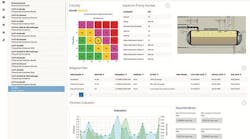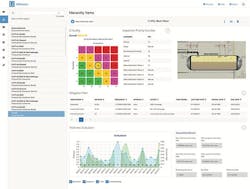Refineries that postpone planned maintenance downtime to boost profits are facing disastrous consequences
The global industrial process and energy market intelligence firm Industrial Info Resources has reported that unexpected refining outages have soared in recent years, with more than 2,000 incidents in 2019.
This is quadruple the number of 2015 outages, and 2020 hasn’t started out much better. In fact, based on incidents in North America in February alone, the trend seems to be continuing, if not getting worse:
- 2/12: “Huge Fire” at oil refinery, Baton Rouge LA
- 2/13: “Explosions” at chemical plant, Newburyport MA
- 2/18: “Massive Fire” at oil refinery, Corpus Christi TX
- 2/25: “Large Fire” at oil refinery, Carson CA
Business reporter Laura Sanicola of Reuters noted in a recent article that insurance costs facing U.S. refining and chemical manufacturers are escalating. Production is at an all-time high with “increasingly complex refineries running full-tilt” and many are postponing planned maintenance downtime to try to boost profits.
This “full tilt” trend also is documented in data from the U.S. Department of Energy (DOE) which shows five straight years of annual increase in refinery utilization, hitting 93.1% uptime in 2018. Throughput also hit a record high in 2018 of 17.3 million barrels per day. Energy industry analysts expect that, when the DOE finalizes reports on 2019, new record highs will extend the trend into a sixth consecutive year. The production of energy and manufacturing of petroleum-based products like plastics, be it to drive industry or to meet end-user consumer demand, will continue to push America’s aging and “increasingly complex” infrastructure to its limits. This trend is raising concerns among many in industry and government (federal, state, and local) to ensure both safe operations of these facilities and protection of the community and surrounding environment. When looking at the alarming number of incidents and the reports of operators deferring planned shutdowns for maintenance, is it really a surprise that we are seeing so many avoidable incidents?
Asset performance management, maintenance, and risk
After 20 years of technical innovation and giant leaps in predictive sciences, one truth is apparent: We still have a lot of work to do to prevent unplanned shutdowns. It is clear that there are many factors at play in this “unmitigated spike in catastrophic incidents” equation. Much has been written on key contributors such as the aging energy infrastructure (particularly in North America), the rapid retirement of and overall downsizing of skilled maintenance and asset reliability professionals, and the huge backlog of work orders that many maintenance teams face. It is this backlog issue that frustrates so many, where maintenance teams are over overwhelmed with work orders stacked up in their Enterprise Asset Management (EAM) or Computer Maintenance Management Systems (CMMS). There appears to be little or no information available to prioritize task criticality; or risk to business, plant, people, and the environment if that work is not done.
Our current dichotomy is that on one hand, we have the amazing new digital twins and machine learning technologies available to transform existing asset management activities, delivering greater prediction of asset failures which ultimately help to prevent unplanned downtime. On the other hand, we continue to face the same fundamental issues, like work order backlogs and/or limited visibility of operating risks, that were being addressed ten years ago when Asset Performance Management (APM) and predictive analytics solutions first started being implemented across asset intensive industries.
The delivery of a comprehensive view and understanding of risk has always been central to the overall capabilities of an APM software platform. To calculate and model risk and consequence of failure, whether from the single component on up to an entire enterprise, is the vision of most APM solution providers. In fact, the role of the Chief Financial Officer (CFO) has grown and evolved over the last 20 years, with a 360-degree view of risk to the business becoming paramount. When the CFO is forecasting earnings and output for the quarter, for example, they need a comprehensive view of risk and consequence of a failure (from the component level all the way to the entire facility) to fully understand the complete impact.
Figure 1. The data proof points and insurance industry expertise make a convincing case for investing in an APM solution based solely on the insurance savings alone. Source: Lloyd’s Register
The CFO takes notice of APM
This connection between asset management, risk, and the CFO’s office grew considerably in 2011 when one of the industry’s leading experts on risk, Don Schubert of Marsh, presented at a number of industry conferences. Don’s specialty was the re-insurance market for industrial clients. Specifically, he would work with the largest energy and chemical producers in the world to broker insurance coverage. He educated his clients and those of us building this technology on just how much money an owner/operator could save if they could demonstrate they had an understanding of their risk profile.
Those cost savings were directly tied to the software systems, processes, and training in place to lower risk and consequence by demonstrating use of an APM solution. Schubert showed conclusively how using an APM platform and preventative/predictive capabilities could reduce the likelihood of an asset failure. The net benefit of the resultant reduction in risk, Schubert said, was significantly lowered insurance costs to the owner/operator: “The insurance industry, when they charge a dollar of insurance to your company, part of that pricing or that dollar is actually based on how well they believe you manage assets and risk.” (See video clip.)
Just what kind of numbers are we talking about? According to Marsh JLT, the overall liability to insurers for global refining and petrochemical incidents from 2017-2019 comes to more than $12.5 billion. Annual insurance premiums for these types of plants are quite expensive. A refiner worth $1 billion will likely pay circa $2.5 million per annum, according to insurance analysts.
“It’s the data [from your APM system] that you use with your insurance people and that funnels through your asset management people and your risk management people, and the results of that make its way to the insurance carrier,” Schubert also said in 2011. “So keep in mind, when we do renewal negotiations for the premium you’re going to be charged for the insurance policies, we do capitalize on what exactly are the programs you have in place, the software you are using, and the results that you see from it.” (See video clip.)
The data proof points and insurance industry expertise make a convincing case for investing in an APM solution (that incorporates predictive/preventative capabilities, risk analysis, and modeling tools), based solely on the insurance savings alone. Obviously, there are many factors to consider, but given “the size of the prize” on how insurance savings factor into a company’s financials, Don Schubert has been proven correct.
Amazingly, LNS Research analyst Joe Perino stated that “of 82 companies surveyed that currently manage Operational Risk with software, only 11% use purpose-built risk software, and 51% use homegrown or financial systems” in a recent report titled Asset Performance Management and Risk Management: A Comprehensive Approach Beyond Asset Reliability. Joe’s current research echoes much of what Don Schubert and Marsh were advocating 10+ years ago. There is a direct relationship between risk and asset performance and its ramifications go well beyond asset reliability and preventative/predictive maintenance.
A comprehensive approach to asset performance and risk management is an essential component of operational excellence. The two were always meant to be one. To quote Don Schubert, “There is no such thing as zero risk. But if you want to move closer to no risk, you must know risk.”
Bob Francis is APM Strategy Leader for Lloyd’s Register, helping asset-intensive industries realize productivity improvements and reduce operating costs while maintaining asset health, reliability, and uptime. Bob has more than 20 years of experience in the APM space, including leadership positions with Aspen Technology, Meridium, and Asset Performance Technologies.

